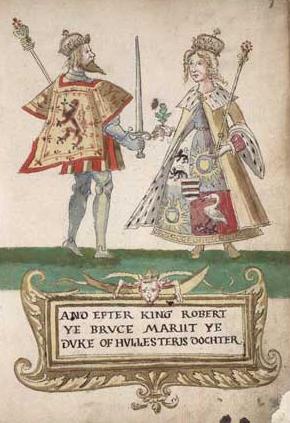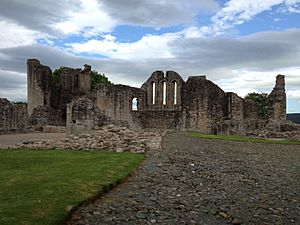Elizabeth de Burgh facts for kids
Quick facts for kids Elizabeth de Burgh |
|
|---|---|

Robert the Bruce and Elizabeth de Burgh, from the Seton Armorial.
|
|
| Queen consort of Scotland | |
| Tenure | 1306–1327 |
| Coronation | 27 March 1306 |
| Born | c. 1289 County Down or County Antrim |
| Died | 27 October 1327 Cullen, Banffshire |
| Burial | Dunfermline Abbey |
| Spouse | Robert I of Scotland |
| Issue | Matilda Margaret David II of Scotland John of Scotland |
| House | de Burgh |
| Father | Richard Óg de Burgh, Earl of Ulster |
| Mother | Margarite de Burgh |
Elizabeth de Burgh (born around 1289 – died 27 October 1327) was the second wife of Robert the Bruce. She was the only queen of Scotland during his reign.
Elizabeth was born around 1289. She likely grew up in what is now County Down or County Antrim in Ulster, a northern part of Ireland.
Her father was Richard Óg de Burgh. He was a very powerful noble in Ireland at that time. He was also a close friend and ally of King Edward I of England.
Not much is known about Elizabeth's life. This is common for many women from the Middle Ages. However, we know she faced many challenges. She was caught up in the wars between Scotland and England. She had to move often to stay safe and was even held prisoner.
Contents
Life of Queen Elizabeth
Early Life and Marriage
Elizabeth was born in Ulster, Ireland, around 1289. Her father was the powerful Lord of Ulster, Richard Óg de Burgh. Her mother was Margarite de Burgh. Elizabeth's father was a good friend of the English King Edward I.
Elizabeth probably met Robert the Bruce at the English royal court. At the time, Robert was the Earl of Carrick. They got married in 1302 in Writtle, England. Robert was a widower with a young daughter from his first marriage. Elizabeth was about 13 years old, and Robert was 28.
Queen of Scots
On 27 March 1306, Robert and Elizabeth were crowned King and Queen of Scots. This important event happened at Scone, a traditional coronation site.
Their crowning was a brave act. It showed they did not accept England's claim to rule Scotland. King Edward I of England had removed the previous Scottish king, John de Baliol.
Captured by the English
After the Scots lost the Battle of Methven in June 1306, Robert sent his family away. Queen Elizabeth, his daughter Marjorie, and his sisters Mary and Christina went to Kildrummy Castle. Robert's brother, Niall, was there to protect them.
The English army attacked the castle where the royal family was hiding. They managed to get inside by bribing a blacksmith. The blacksmith set fire to the castle's food storage. Niall Bruce and all the men defending the castle were executed.
However, the royal ladies had already escaped. They were escorted by the Earl of Atholl. They tried to find safety at a church called St. Duthac at Tain.
But they were captured by the Earl of Ross, who supported the English. He sent them to King Edward I. Edward imprisoned Robert's sister Mary and Isabella, Countess of Buchan, in wooden cages on castle walls. Robert's nine-year-old daughter Marjorie was sent to a nunnery.
Elizabeth was held under strict house arrest in England. This was because King Edward still needed help from her powerful father. The Earl of Atholl, who helped the ladies escape, was executed. His head was displayed on London Bridge.
Elizabeth was held prisoner by the English for eight years. She was moved to different places during this time. She even wrote a letter complaining about her poor living conditions. She had very few clothes and no proper bedding.
After the Battle of Bannockburn in 1314, she was moved to York. This was when talks began to exchange prisoners. She met King Edward II of England there. Elizabeth was finally released on 29 September 1314. She was part of a prisoner exchange for the Earl of Hereford, who the Scots had captured.
Queen Elizabeth had three children who grew up to be adults: Matilda, Margaret, and David. David later became King David II of Scotland.
Her Final Years
Elizabeth died on 27 October 1327, at about 38 years old. She fell from her horse during a visit to the royal home in Cullen, Scotland.
Her body was taken to Dunfermline Abbey in Fife. This abbey was the burial place for Scottish kings and queens since 1093. People in Cullen were worried her body might not arrive safely. So, they removed her internal organs during the embalming process. Some say her organs were buried in the local church in Cullen.
King Robert was very grateful for how Elizabeth's body was cared for. He ordered that a special chaplaincy be set up at the old church in Cullen. He paid money every year for Masses to be said for Elizabeth's soul. This payment continued for centuries.
In 2011, the church's minister asked the local council to restart the payments. After looking into it, the council agreed. They now pay a small amount each year. A prayer is also said for the Queen during a Sunday service.
When King Robert died 18 months later, he was buried next to Elizabeth. She had been laid to rest in the center of the abbey, under the main altar. Her tomb was made of alabaster and decorated with gold.
The abbey was damaged in 1560 during the Scottish Reformation. Elizabeth's tomb was lost. However, King Robert's coffin was found again in 1819. Elizabeth's coffin was rediscovered in 1917. Both were reburied in the new abbey.
Her Children
Elizabeth and Robert the Bruce had the following children:
| Name | Birth | Death | Notes |
|---|---|---|---|
| Margaret | between 1315 and 1323 | 30 March 1346 in childbirth |
Married William de Moravia, Earl of Sutherland. They had one son, John, who died young. |
| Matilda (Maud) | 30 July 1353 | Married Thomas Isak/Isaac. They had two daughters, Joanna and Catherine. She was buried at Dunfermline Abbey. | |
| David | 5 March 1324 | 22 February 1371 | He became King of Scots from 1329 to 1371. He married Joan of England and later Margaret Drummond. He had no children. |
| John | 5 March 1324 | October 1327 Dunfermline Palace, Fife |
He was David II's younger twin brother. He was an heir to the Scottish Crown. |
| Elizabeth Bruce | Unknown | After 1364 | Married Sir Walter Oliphant. |
See also




